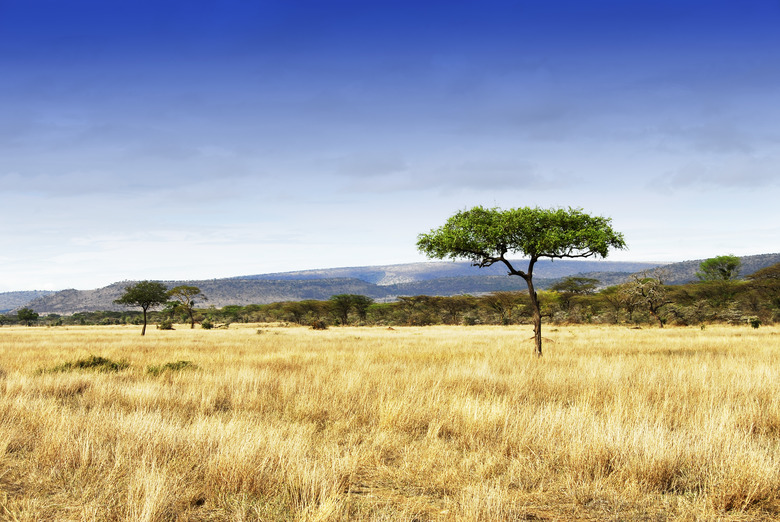Biotic Factors In The Grassland Biome
Grasslands make up one of Earth's major terrestrial biomes. Dominated by grasses and shaped by other biotic factors, different types of grasslands exist in tropical and temperate climates. Tropical grasslands cover much of Africa, Australia, South America and India, including the African savanna. Temperate grasslands include the North American prairies, as well as areas of Europe, South America, and the steppes of Russia and northern Asia.
Plants
Plants
Grassland biomes are fueled by a plethora of different grasses and forbes. The types of grasses present depend on the climate and location of the grassland, but all grasses have some basic characteristics in common. Grasses are well adapted to live in regions prone to drought and fire. The long, narrow leaves of grass lose water less rapidly than broad-leafed plants. The silica present in the leaves of many grasses makes them strong enough to grow tall and maximize exposure to sunlight. The plants store much of their energy underground in their rhizomes and root system, so when leaves are killed by fires or predation, the plants can easily send up new growth.
Invertebrates
Invertebrates
Numerous insects and other invertebrates live in grasslands. Some of the insects, such as grasshoppers, locusts and caterpillars, consume the grasses and act as grazers. Others, such as earthworms, serve crucial underground roles, helping to decompose organic matter and maintaining soil health. Invertebrates also provide an important food source for the many bird species that inhabit grasslands.
Grazers
Grazers
Some types of animals are specially adapted to consume hard-to-digest grass leaves. Grasslands represent an ecological relationship between grasses and grazing animals. Whether the animals are wildebeest and zebras or bison and elk, the grazing herds help shape grasslands. Grazing animals help control tree growth to prevent competition pressures on grasses. Grazing also helps promote new growth in grasses as older, less productive parts of the grass leaves are cut off by grazers. The animals also help fertilize grasslands, returning nutrients to the soil through their manure. Other small animals, such as ground squirrels, rabbits and other burrowing mammals help shape grasslands.
Predators
Predators
The herds of grazing animals present on many grasslands live in relationship with the grassland predators. Predators help prevent over population of prey populations and also help keep the population healthier by preying on sick, injured and older individuals. Without predators, prey species such as deer can overpopulate an area, leading to starvation and illness within the hear. Tropical grasslands, such as Savannas, boast charismatic predators such as lions, cheetahs and jaguars. Predators in temperate grasslands, such as prairies, include foxes, birds of prey, bobcats, coyotes and wolves in areas where they have not been extirpated.
Cite This Article
MLA
Cummings, Eliza. "Biotic Factors In The Grassland Biome" sciencing.com, https://www.sciencing.com/biotic-factors-grassland-biome-8402092/. 22 November 2019.
APA
Cummings, Eliza. (2019, November 22). Biotic Factors In The Grassland Biome. sciencing.com. Retrieved from https://www.sciencing.com/biotic-factors-grassland-biome-8402092/
Chicago
Cummings, Eliza. Biotic Factors In The Grassland Biome last modified March 24, 2022. https://www.sciencing.com/biotic-factors-grassland-biome-8402092/
